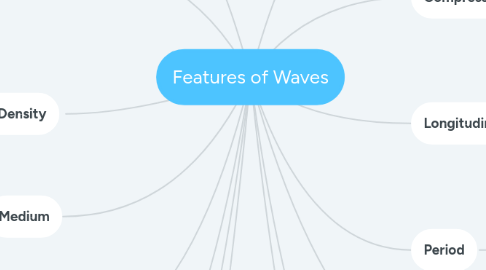
1. Crest
1.1. The highest part of a wave
2. Frequency
2.1. The number of times something occurs in a given period of time.
2.1.1. The frequency of a wave is equal to the number of waves that pass a point each second.
2.1.2. The unit of frequency is the hertz (Hz). One hertz is one event per second.
2.1.3. If the speed is held constant, shorter wavelengths will correspond to higher frequencies, and longer wavelengths will correspond to lower frequencies.
3. Linear Mass Density
3.1. The amount of mass per unit of length.
3.1.1. Linear mass density is measured in kilograms per meter
3.1.2. For example, a 10-meter rope with a mass of 13 kilograms has a linear mass density of 1.3 kg/m.
4. Medium
4.1. A substance through which waves can travel.
5. Rarefaction
5.1. A part of a longitudinal wave where the particles in the medium are spread apart.
6. Transverse Wave
6.1. A wave in which the motion of the medium is perpendicular to the direction of the wave
7. Wave
7.1. A repeating motion that travels through a medium.
7.1.1. Particles in the medium move up and down and/or back and forth as the wave passes through
7.1.2. The particles in the medium do not move permanently when the wave passes through. After the wave passes, the particles eventually move back to their original rest positions.
8. Wave Speed
8.1. The distance a wave travels in a given amount og time
8.1.1. Wave speed (v) is equal to the product of a wave's frequency (f) and its wavelength v = (lambda) x f
9. Amplitude
9.1. The maximum distance a point is moved from its rest position when a wave passes through.
9.1.1. For a transverse wave, the amplitude is the distance a point is moved up or down when a wave passes through.
9.1.2. For a longitudinal wave, the amplitude is the distance a point is moved left or right as the wave passes through.
10. Compression
10.1. A part of a longitudinal wave where the particles in the medium are pushed together.
11. Longitudinal Waves
11.1. A wave in which the motion of the medium is in the same direction as the wave.
12. Period
12.1. the time required for a single event to occur.
12.1.1. The period of a wave is the time required for one full wave to pass a location.
13. Power
13.1. The rate at which work is done
13.1.1. Power is equivalent to the amount of energy produced in a given time.
13.1.2. The unit of power is the watt(W). One watt is equal to one joule per second.
14. Trough
14.1. The lowest part of a wave
15. Wavelength
15.1. The distance between neighboring crests, neighboring troughs, or any other neighboring equivalent points of a wave.
15.1.1. Wavelength is represented by the Greek letter (lambda)

